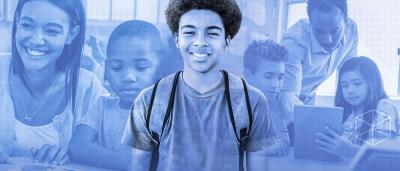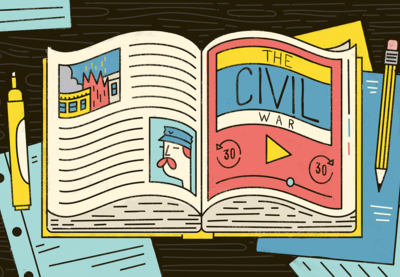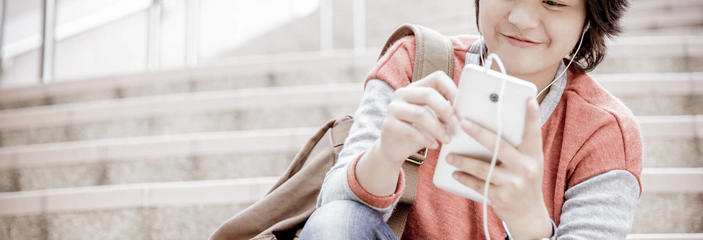There’s a common phrase in radio production: “Radio has the best pictures.”
And it’s true. The scenes we imagine for ourselves—those sketched by the voices of hosts and reporters we trust the most—rarely disappoint.
That adage may explain one reason why podcasts have become so popular in the last decade. But podcasts are more than just radio shows. Podcasters aren’t bound by a 30-minute episode frame, a newspaper editor’s column inches or a book publisher’s idea of what will sell. The expandable limits of the medium mean that episodes, series and entire shows can offer deep dives into complicated subjects. They can take the time they need to tell stories that haven’t been told before. They can include the most recent news, the most relevant sources. And they can, quite literally, bring new voices into conversation with one another.
Educators are getting students in on this conversation as well, turning to podcasts as an additional resource for tackling complex social justice topics.
Lessons on Inequality
In Anthony Maida’s high school government classes, for example, students learn about school integration by listening to “The Problem We All Live With,” a 2015 series of episodes on the podcast This American Life.
The series provides a clear overview of a complex problem—something students might have trouble finding elsewhere. New York Times journalist Nikole Hannah-Jones, who hosts the series, has spent years reporting and writing on school segregation.
Maida focuses on segregation and educational inequity because it’s a problem many of his students do not readily see. The student body at his high school, in a suburb outside of Philadelphia, is about 70 percent white.
“I teach and live in a bubble here, and these kids have no exposure to anyone who is unlike them,” he says. “And they, frankly, leave here believing that every high school education is just like theirs, and it’s not.”
He points to disparities in funding, noting that his school district spends about $22,000 per student, compared to less than $10,000 that the School District of Philadelphia spends per student.
“So, we’re asking those types of questions, like: ‘Why is your high school education worth twice [what] a kid in Philadelphia’s high school education is worth?’”
“The Problem We All Live With” impressed Maida with its content and its potential for engaging students. “I’m a big believer that any time I’m not standing in front of a classroom talking is better teaching,” he says. “If they’re listening to a podcast, it focuses them a little bit, but the biggest benefit is they’re hearing it from someone who’s not me.”
He teaches the podcast like any other text, which includes scaffolding student learning. Before they listen, students learn about domestic policy, reading and discussing Jonathon Kozol’s Savage Inequalities: Children in America’s Schools. As they listen, they respond and make connections to the episodes and accompanying books using their district-issued Google Chromebooks.
On This American Life’s website, the page for “The Problem We All Live With” features the famous Normal Rockwell illustration of Ruby Bridges. It’s an image of segregation that aligns with many people’s ideas about the practice: that it was an injustice firmly located in a distant past, one long before Maida’s students—or even their parents—were born.
But segregation in U.S. schools is a 21st-century problem. And that’s one clear benefit of reporting-based podcasts like “The Problem We All Live With.” Students can listen to Hannah-Jones supplement her own reporting with recordings of her sources: other students, educators, even former U.S. Secretary of Education Arne Duncan.
Hearing their voices drives home an idea that students may already know but not always consider: that those affected by segregation—and those who have the power to shape policy to end it—aren’t frozen in paintings or history books. They’re living, breathing people.
"Seeing White" in the Classroom
The genre may be particularly well suited to introducing or explaining complex policy, but educators say that reporting isn’t the only thing podcasts do well. Since they’re designed to be consumed independently, podcasts also offer educators a way to provide students with valuable context or deep dives into topics related to—but not an explicit part of—course content.
Stephanie Flores-Koulish, associate professor and director of the Curriculum and Instruction for Social Justice graduate program at Loyola University Maryland, uses the Scene on Radio podcast series “Seeing White” just this way in her graduate education courses.
“The idea of white privilege is a big element to understanding,” she says. “And my teachers aren’t all white, but they tend to predominately be white—much like the teaching force.”
When John Biewen, a radio journalist and audio director at the Center for Documentary Studies at Duke University, began working on “Seeing White,” he wanted to challenge audiences to rethink how they view whiteness. By the end of the series, listeners come away with a deeper understanding of how the concept of whiteness shapes oppressive American structures.
Flores-Koulish uses the podcast primarily to supplement course content, to give students an opportunity to consider how issues around identity, power and intersectionality might affect their futures as educators.
“I found that it was such an engaging, in-depth way to cover the topics that I wanted them to understand,” she said. “And they could do it outside of class.”
Anastasia Shown, a lecturer at the University of Pennsylvania’s School of Social Policy & Practice, conducts K–12 outreach and training. She teaches with “Seeing White,” as well. Like Maida, she treats the podcast as a course text. But she also builds on materials produced especially for students.
When the podcast first launched, Biewen didn’t expect he’d have an audience of educators asking for transcripts so they could use the content in their classrooms. But when the requests came in, he obliged and went a step further, creating a bibliography and study guide for listeners.
“I find specific episodes that sit within my syllabus, and I use the content in the online study guide, which is great,” Shown says. “I tell the students, ‘Go to the study guide; answer those questions.’ We’ll get in discussion groups, or sometimes they have to write a reflection paper after listening to one of the episodes.”
That’s exactly what Biewen had in mind when he produced the resources. “The spirit of something like ‘Seeing White’ is so tied up with the realization that most of us are not ... getting a very clear picture of who we actually are in the classroom,” he says. “So, when you hear that teachers today are seeing this as an opportunity to do something different ... it’s really, really gratifying.”
Did You Know?
In June 2018, Apple reported there were 550,000 podcasts streaming, and according to Podcast Insights, that number has already jumped to more than 700,000 in 2019.
Did You Know?
Forty percent of people between ages 12 and 24 listened to a podcast in 2018, compared to 30 percent in the year prior, according to statistics by Edison Research and Triton Digital in their Infinite Dial report.
Ransacking History
Even as podcasts in general become more popular among educators, some stand out as hits. Among these is Uncivil, a podcast that digs deep into the history of the Civil War. Along with their team, the podcast’s co-creators and co-hosts, Jack Hitt and Chenjerai Kumanyika, often highlight stories of black resistance to enslavement.
“We realize the dominant history, the main history, of the Civil War was false and impoverished,” says Kumanyika. “It was the product of having been rewritten, which we outline in episode four. But also because it was just missing so many important stories.”
Focusing on the power of black people fighting for freedom and asserting their agency, stressing that black people helped make American history, Uncivil offers students a different understanding of the Civil War era.
The show’s attention to recovering history may be the reason that Hitt and Kumanyika, who also serve as co-executive producers for the show, so often hear from teachers who use their podcast in the classroom. But it’s not just the content teachers and students are responding to—it’s also the tone.
The celebratory approach to recovering a history that’s been lost is woven throughout the podcast. It’s apparent not only in the stories but also in the choice of music throughout the episodes—another attention-grabber for young listeners. In place of the stereotypical, gloomy banjo music that’s standard in antebellum narratives, the hosts chose upbeat music from the African American tradition, including original work from a Charleston, South Carolina, ensemble called Ann Caldwell and the Magnolia Singers.
And it’s clear in the ways the co-hosts approach the stories they tell. Kumanyika, who also worked with Biewen on “Seeing White,” explains that it matters that he, a young, African American professor, tells these stories using language and expressions familiar to a young audience.
“I’m coming at it as not an expert, first of all, of the Civil War, but someone who’s curious,” he explains. “I’m coming at it as somebody who, probably when I was in middle school, thought this topic was boring, which is what I think a lot of people do think: It’s boring. But in fact, it’s super exciting.”
That excitement—and the investment and dedication that shine through every episode of all of these podcasts—may be another reason that more and more of the shows are making their way into classrooms.
Podcasts are a form of public history-making, which students themselves can emulate. Podcasts get students excited and teach them the basics of topics in history, policy or social justice. But they also model how to do history, policy or social justice. And they’re evidence of the value of that work.
“There’s so much work going on at the high school level where those teachers may not have support,” Kumanyika says. “They’re trying to find an interesting way to keep the students engaged and to give them a more rigorous history than the one that we grew up with. I see myself very much in solidarity with that.”
Podcast Spotlight: The Loving Project
A podcast and accompanying study guide that delve into a landmark Supreme Court case
By Coshandra Dillard
In 1967, the Supreme Court issued a landmark decision in Loving v. Virginia, striking down state laws that criminalized interracial marriage. In 2017, to celebrate the 50th anniversary of Loving, Farrah Parkes and Brad Linder interviewed 25 other interracial couples from the Philadelphia area. They were eager to share the couples’ stories, in their own voices, for a podcast called The Loving Project.
Parkes, who grew up in Jamaica, admits that her knowledge of American history was limited and that she didn’t learn about Loving until she was in graduate school (and after she married Linder).
She says she wants the podcast to help young people “get a different understanding of what it means to be a family, what families are—and an understanding of how the United States has tried to police family over the years.”
“I would like to hope that this helps as they think about how they view the world and their place in it,” she says.
Parkes and Linder didn’t expect the project to become an educational tool used in the classroom and adapted for various grade levels.
But thanks to the help of one interviewee, the podcast has an accompanying study guide to help teachers use the content.
Anastasia Shown, a lecturer at the University of Pennsylvania’s School of Social Policy & Practice, was interviewed for The Loving Project. Afterward, she gathered education and social work students from her program and from Penn State Abington, as well as practicing teachers from the area, to help develop the guide.
It features lesson plans, discussion questions and links to additional resources related to the podcast.
Dillard is a staff writer for Teaching Tolerance. Delacroix, who edited to this piece, is associate editor.

Check out the toolkit for this story! The toolkit includes everything you need to put this story into action, including additional resources and recommendations to incorporate into your classroom.


